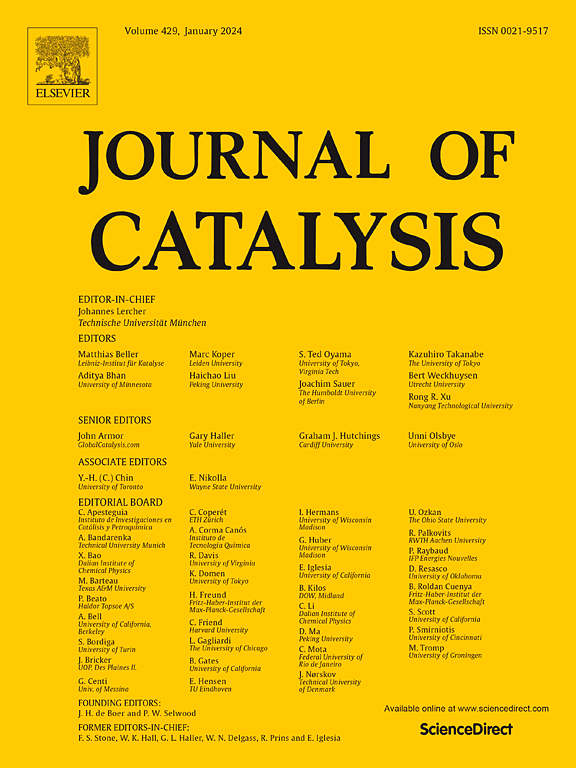具有定制d波段中心的双金属NiCu催化剂源自纳米花状ldh,用于马来酸酐加氢的高效和可调选择性
IF 6.5
1区 化学
Q2 CHEMISTRY, PHYSICAL
引用次数: 0
摘要
顺丁烯二酸酐直接加氢的主要产物是丁二酸酐(SAH)和γ-丁内酯(GBL)。通过调节马来酸酐加氢的组成、结构和织构性能来实现这些产物的选择性合成仍然是马来酸酐加氢领域的研究热点。基于层状双氢氧化物阳离子原子水平均匀分布的特点,以层状双氢氧化物为前驱体,合成了一种高负载、高分散、均质化的NiCu合金双金属催化剂。与NiAl-LDHs衍生的Ni/Al2O3催化剂相比,Cu的引入可以有效提高C=C键的加氢活性,同时抑制C=O键的氢解。在相同的反应条件下,Ni/Al2O3催化剂的主要产物是γ-丁内酯(GBL),收率为94.2 %;NiCu0.4/Al2O3催化剂的主要产物是琥珀酸酐(SAH),收率为90.5 %。Cu的引入导致催化剂中NiCu合金相的形成,显著影响了反应物和中间体的吸附构型和吸附能。这种效应可以归因于Ni和Cu之间的电子相互作用,使Ni的d带中心远离费米能级,从而促进了琥珀酸酐(SAH)和γ-丁内酯(GBL)的定向合成。这些发现被各种表征技术和DFT理论计算证实。本研究提出的设计方法和研究思路将极大地促进马来酸酐加氢催化剂的发展。本文章由计算机程序翻译,如有差异,请以英文原文为准。


Bimetallic NiCu catalyst with tailored d-band center derived from nanoflower-like LDHs for efficient and tunable selectivity of maleic anhydride hydrogenation
The primary products of the direct hydrogenation of Maleic Anhydride (MA) are Succinic Anhydride (SAH) and γ-butyrolactone (GBL). Achieving selective synthesis of these products by regulating the composition, structure, and textural properties remains a focal point in the research field of maleic anhydride hydrogenation. Based on the characteristic of atomic level uniform distribution of cations of layered double hydroxides (LDHs), a highly loaded, highly dispersed and homogenized NiCu alloy bimetallic catalyst was synthesized using NiCuAl-LDHs as precursor. Compared with Ni/Al2O3 catalyst derived from NiAl-LDHs, the introduction of Cu can effectively improve the hydrogenation activity of C=C bonds while inhibiting the hydrogenolysis of C=O bonds. Under identical reaction conditions, the primary product of the Ni/Al2O3 catalyst was γ-butyrolactone (GBL) with a yield of 94.2 %, whereas the primary product of the NiCu0.4/Al2O3 catalyst was Succinic Anhydride (SAH) with a yield of 90.5 %. The introduction of Cu resulted in the formation of a homogeneous NiCu alloy phase in the catalyst, which significantly influenced the adsorption configurations and adsorption energies of the reactants and intermediates. This effect can be attributed to the electronic interactions between Ni and Cu, which shift the d-band center of Ni away from the Fermi energy level, thereby facilitating the directed synthesis of Succinic Anhydride (SAH) and γ-butyrolactone (GBL). These findings were confirmed by various characterization techniques and DFT theoretical calculations. Future catalyst development in maleic anhydride hydrogenation will significantly benefit from the design approach and research ideas presented in this study.
求助全文
通过发布文献求助,成功后即可免费获取论文全文。
去求助
来源期刊

Journal of Catalysis
工程技术-工程:化工
CiteScore
12.30
自引率
5.50%
发文量
447
审稿时长
31 days
期刊介绍:
The Journal of Catalysis publishes scholarly articles on both heterogeneous and homogeneous catalysis, covering a wide range of chemical transformations. These include various types of catalysis, such as those mediated by photons, plasmons, and electrons. The focus of the studies is to understand the relationship between catalytic function and the underlying chemical properties of surfaces and metal complexes.
The articles in the journal offer innovative concepts and explore the synthesis and kinetics of inorganic solids and homogeneous complexes. Furthermore, they discuss spectroscopic techniques for characterizing catalysts, investigate the interaction of probes and reacting species with catalysts, and employ theoretical methods.
The research presented in the journal should have direct relevance to the field of catalytic processes, addressing either fundamental aspects or applications of catalysis.
 求助内容:
求助内容: 应助结果提醒方式:
应助结果提醒方式:


